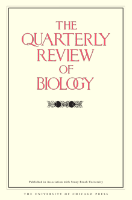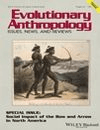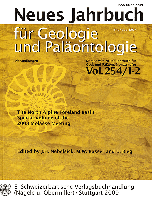
ORIGINS OF LIFE AND EVOLUTION OF BIOSPHERES
Scope & Guideline
Unraveling the Mysteries of Life’s Origins and Evolution
Introduction
Aims and Scopes
- Prebiotic Chemistry and Molecular Evolution:
The journal emphasizes research on the chemical pathways that may have led to the formation of life, including studies on amino acids, nucleotides, and other biomolecules in prebiotic environments. - Homochirality and Asymmetry:
A core focus is on the origins and significance of biological homochirality, examining the mechanisms that could have led to the preferential formation of one chiral form over another in prebiotic conditions. - Mineral-Microbe Interactions:
Research on how minerals may have facilitated or influenced the emergence of life is prevalent, including the adsorption of organic molecules onto mineral surfaces and their roles in chemical evolution. - Astrobiology and Extraterrestrial Life:
The journal explores the implications of life’s origins in the context of astrobiology, investigating potential biosignatures and conditions that may support life beyond Earth. - Evolutionary Biology and Molecular Mechanisms:
It also covers evolutionary approaches to understanding biological complexity, including the evolution of metabolic pathways, genetic codes, and the role of environmental factors in shaping life.
Trending and Emerging
- Experimental Prebiotic Chemistry:
There is a growing emphasis on experimental studies that simulate prebiotic conditions to understand the chemical pathways leading to life, showcasing innovative methodologies and interdisciplinary approaches. - Chiral Chemistry and Asymmetric Synthesis:
Research on the origins of chirality and its implications for biological processes is trending, with an increasing number of studies focusing on asymmetric synthesis and its relevance to prebiotic chemistry. - Computational Models and Simulations:
The use of computational approaches to model prebiotic processes and evolutionary dynamics is on the rise, indicating a shift towards integrating theoretical frameworks with experimental data. - Astrobiological Implications of Prebiotic Research:
There is an emerging focus on how findings in prebiotic chemistry can inform our understanding of potential life on other planets, enhancing the dialogue between origins of life research and astrobiology.
Declining or Waning
- Traditional Genetic Mechanisms:
Research focused on classical genetic mechanisms of evolution has become less prominent, possibly due to a growing interest in broader evolutionary dynamics and non-genetic factors influencing life. - Historical Geobiology:
Studies centered on historical geobiological contexts, such as specific geological periods or localized studies of life’s history, appear to be declining, possibly as the journal pivots toward more experimental and theoretical approaches. - Single-Organism Studies:
There seems to be a decrease in publications focusing solely on single organisms in isolation, as the trend shifts towards understanding interactions within ecosystems and broader biological networks.
Similar Journals

Theology and Science
Navigating the Terrain Where Theology Meets Empirical ResearchTheology and Science is a leading journal that explores the intricate relationships between theological discourse and scientific inquiry, contributing to the growing dialogue in the fields of Religious Studies, History, and Philosophy of Science. Published by the reputable ROUTLEDGE JOURNALS, TAYLOR & FRANCIS LTD in the United Kingdom, this journal provides a platform for high-quality research, fostering multidisciplinary approaches and addressing the philosophical implications of scientific developments from a theological perspective. With an impressive 2023 impact factor placing it in the Q1 category for Religious Studies and Q2 for both History and Philosophy of Science and Multidisciplinary studies, Theology and Science is positioned to influence academic discourse and shape contemporary understanding. Researchers, professionals, and students alike will find valuable insights and thought-provoking articles that not only advance scholarship but also bridge gaps between these two vital fields of human understanding.

Annual Review of Entomology
Exploring the Intricacies of Insect LifeAnnual Review of Entomology, published by Annual Reviews, is a premier journal dedicated to advancing the understanding of entomology through comprehensive review articles from leaders in the field. With a focus on Ecology, Evolution, Behavior, and Systematics and Insect Science, the journal ranks in the top quartile (Q1) as of 2023, reflecting its significant impact and relevance in these disciplines. Based in the United States, the Annual Review of Entomology has been a trusted resource since its inception, providing critical insights that inform research, policy, and education in entomology. Researchers and professionals will find valuable reviews that synthesize current knowledge and highlight future directions in insect research. The journal's impressive standing, as indicated by its rankings—first in both Agricultural and Biological Sciences categories—emphasizes its pivotal role in shaping scientific discourse and innovation.

Annual Review of Ecology Evolution and Systematics
Unveiling Insights into Ecology and Evolutionary BiologyThe Annual Review of Ecology, Evolution, and Systematics, published by Annual Reviews, is a leading academic journal dedicated to advancing the understanding of ecological and evolutionary processes. With a commendable impact factor and impressive rankings—9th in both the Ecology, Evolution, Behavior and Systematics category and the Environmental Science category—this journal is recognized for its rigorous peer-reviewed articles that synthesize research findings across a wide range of topics within the fields of ecology and evolutionary biology. Established in 2003, this annual publication aims to provide researchers, professionals, and students with comprehensive insights into the latest developments and trends within these dynamic disciplines. By facilitating access to high-quality scholarly articles, the Annual Review of Ecology, Evolution, and Systematics continues to play a crucial role in fostering scientific discourse and discovery.

QUARTERLY REVIEW OF BIOLOGY
Championing High-Quality Research in Life SciencesQUARTERLY REVIEW OF BIOLOGY, published by University of Chicago Press, stands as a premier journal dedicated to the dissemination of high-quality research and review articles in the field of biological sciences. With an impressive impact factor and an esteemed ranking of Q1 in the Agricultural and Biological Sciences category, the journal is a vital resource for researchers, professionals, and students aiming to stay at the forefront of biological research and developments. Since its inception in 1945, the journal has evolved to cover a broad scope of topics, fostering interdisciplinary dialogue and providing critical insights that promote scientific advancement. Although currently not an open access journal, its reputation is underscored by a remarkable standing in the 95th percentile across Scopus rankings within its field. Located in Chicago, Illinois, this journal continues to be a cornerstone for scholarly communication in biology, making valuable contributions to both academia and practical applications in the biological sciences.

EVOLUTIONARY ANTHROPOLOGY
Innovating Insights into Our Evolutionary PastEVOLUTIONARY ANTHROPOLOGY is a premier journal published by WILEY, dedicated to advancing the field of anthropology through innovative and rigorous research. With an ISSN of 1060-1538 and an E-ISSN of 1520-6505, this journal boasts a remarkable Q1 ranking in both the Anthropology and Medicine (miscellaneous) categories, reflecting its significant impact within the academic community. Since its inception in 1992, it has continuously evolved, now encompassing a wide array of subjects pertinent to evolutionary studies and human health. Residing in the highly competitive Scopus rankings, it stands at an impressive rank of 10 out of 502 in the field, placing it within the top 2% of journals in Social Sciences - Anthropology. Researchers, professionals, and students alike will find this journal an invaluable resource for the latest findings, theoretical advancements, and discussions that shape our understanding of human evolution and its biological implications. While not categorized as an Open Access journal, EVOLUTIONARY ANTHROPOLOGY remains a vital outlet for high-quality scholarship, fostering dialogue and enriching knowledge across diverse audiences.

Serbian Astronomical Journal
Engaging Minds in the Quest for Cosmic KnowledgeSerbian Astronomical Journal, published by the Astronomical Observatory Belgrade, serves as a significant platform for research and innovation within the field of astronomy and astrophysics. With an established publication history since 1992 and an Open Access model, the journal ensures that its cutting-edge research is accessible to a global audience. The journal is recognized for its contribution to the scientific community, evidenced by its solid position in the 2023 Scopus category quartiles, ranking Q3 in Astronomy and Astrophysics. This positions it among notable journals in the discipline, despite being at the 18th percentile of its category rankings. Researchers, professionals, and students will find in Serbian Astronomical Journal a valuable resource for disseminating findings, exploring new discoveries, and engaging with contemporary challenges in astronomy. As the journal continues to evolve, it remains dedicated to advancing the knowledge and understanding of the universe.

Journal of Earth Science
Pioneering discoveries in geology and environmental science.Journal of Earth Science, published by the China University of Geosciences, Wuhan, is a leading journal in the field of Earth and Planetary Sciences, recognized for its significant contributions to the understanding of geological processes and environmental challenges. With an impressive Q1 ranking among Earth and Planetary Sciences journals and a strong position at Rank #39/195 in Scopus, this journal not only showcases high-quality research but also serves as a crucial platform for disseminating innovative findings, spanning a broad spectrum of topics from geophysics to climate change. The journal adopts an open access model, which enhances the visibility and accessibility of research articles published from 2009 to 2024, thereby facilitating collaboration and knowledge sharing among the global scientific community. With its commitment to advancing geosciences, Journal of Earth Science is invaluable for researchers, professionals, and students alike, eager to stay informed and contribute to ongoing discussions in this dynamic field.

Biological Theory
Illuminating the Pathways of Life SciencesBiological Theory is an esteemed academic journal published by Springernature, focusing on the interdisciplinary realms of ecology, evolution, behavior, and philosophy of science. With an ISSN of 1555-5542 and an E-ISSN of 1555-5550, the journal had its converged years from 2006 to 2011 and from 2013 to 2024, reflecting its commitment to ongoing scholarly dialogue. Notably, it holds a prestigious Q2 ranking in Ecology, Evolution, Behavior and Systematics, and an impressive Q1 ranking in History and Philosophy of Science, highlighting its influential role in shaping discussions across these fields. The journal is well-received in the academic community, with Scopus rankings placing it in the 88th percentile for History and Philosophy of Science and the 59th percentile for Ecology, demonstrating its broad impact and relevance. Researchers, professionals, and students can access cutting-edge theories and critical analyses of biological concepts that contribute to a deeper understanding of life sciences without an open access model, further emphasizing the journal's significance in both historical and contemporary scientific discourse.

ChemSystemsChem
Exploring the Frontiers of Chemical ResearchChemSystemsChem is a pioneering open-access journal published by WILEY, dedicated to advancing the field of chemistry and its interdisciplinary applications. With an impact factor reflecting the journal's quality and relevance, it stands at the forefront of chemistry disciplines, showcasing innovative research in chemistry, biochemistry, and chemical engineering. The journal's Scopus rankings highlight its significant presence, ranking #22 out of 111 in Chemistry (Miscellaneous), #142 out of 438 in Biochemistry, and #32 out of 68 in Chemical Engineering – Catalysis. This makes it an essential platform for the dissemination of critical findings from 2019 to its converged years in 2024. Researchers, professionals, and students are encouraged to explore the extensive range of accessible articles that facilitate a deeper understanding of key concepts and emerging trends, fostering collaboration and innovation within the chemistry community.

NEUES JAHRBUCH FUR GEOLOGIE UND PALAONTOLOGIE-ABHANDLUNGEN
Bridging the Past and Present of Planetary ScienceNEUES JAHRBUCH FUR GEOLOGIE UND PALAONTOLOGIE-ABHANDLUNGEN, published by E SCHWEIZERBARTSCHE VERLAGSBUCHHANDLUNG, is a distinguished scholarly journal based in Germany that has made significant contributions to the field of Earth and Planetary Sciences with a particular emphasis on Paleontology. With its ISSN: 0077-7749, this journal provides an essential platform for researchers, professionals, and students to explore cutting-edge research and developments that enhance our understanding of geological and paleontological processes. Boasting a robust ranking of #67 out of 113 in Scopus for the category of Earth and Planetary Sciences and achieving a Q3 quartile ranking in Paleontology, it stands as a significant resource in the global academic community. Though not an open-access journal, it offers valuable insights from 1987 onwards, ensuring a comprehensive archive of high-quality research articles published from 1995 to 2024. Its scholarly impact continues to resonate, making it a vital reference point for advancements in the ever-evolving disciplines of geology and paleontology.